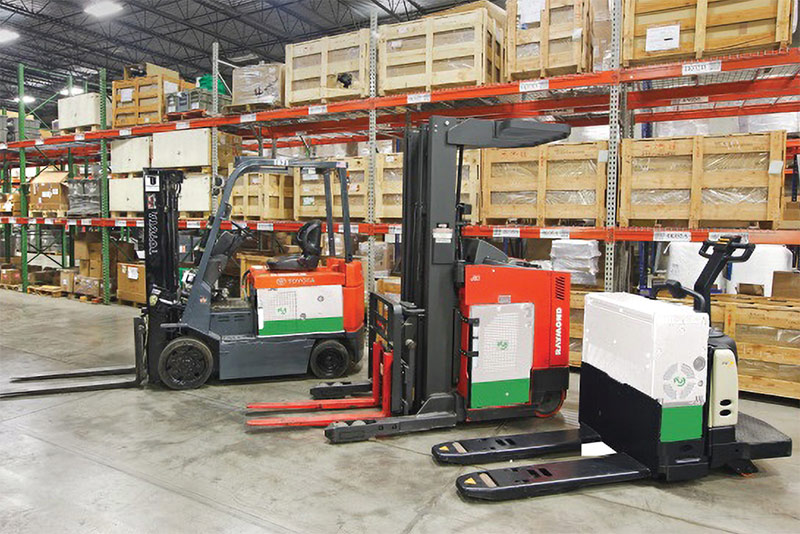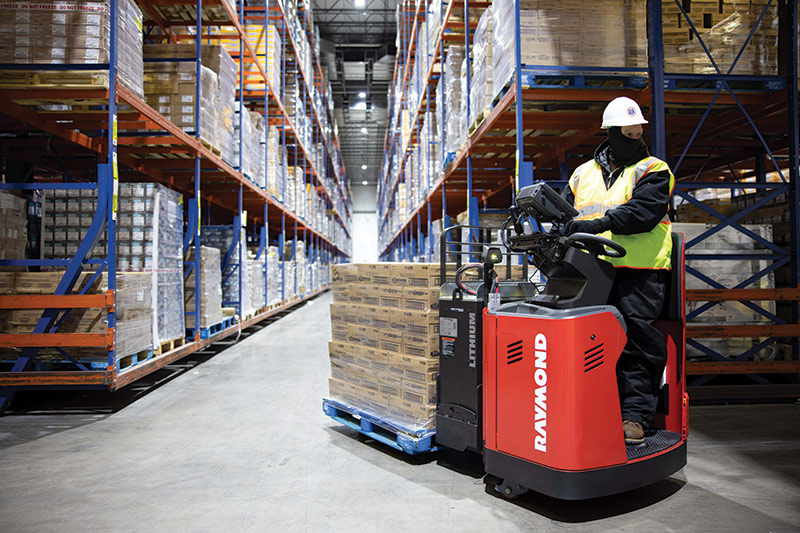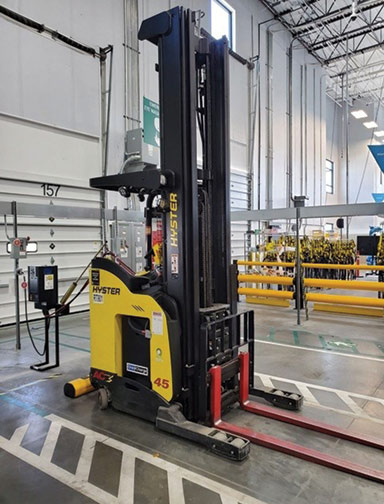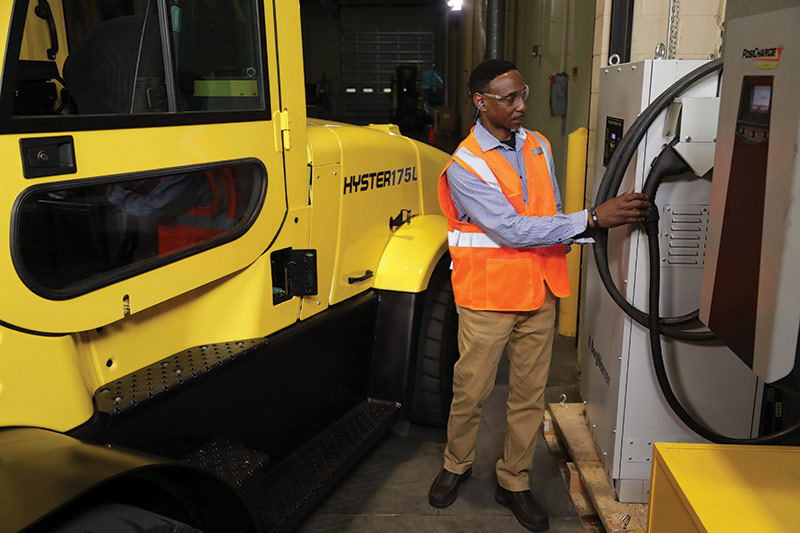User priorities drive motive power choice
Operational priorities and infrastructure constraints should guide motive power choice, though lithium is seen as gaining ground in the long term. Every option has its strong points, so it comes down to using the goals of each operation to guide it down the best motive power path.

 The proverbial fork in the road comes fast when an operation starts looking at all the power choices available for lift truck fleets.
The proverbial fork in the road comes fast when an operation starts looking at all the power choices available for lift truck fleets.
The options include lead-acid batteries, which remain the bulk of the market for electric trucks used indoors; newer advanced twists on lead-acid such as thin-plate pure lead (TPPL) designed for opportunity charging; and lithium-ion (Li-ion) batteries in multiple chemistries, which boast impressive productivity gains for higher volume, multi-shift operations because of their fast opportunity charging and other advantages.
Hydrogen fuel cells are another option, and oh yes, you can opt for “drop-in” Li-ion batteries, or integrated Li-ion solutions where the truck is designed around the more compact battery size.
But all those options can get confusing if you don’t let your fleet and application needs guide you in the right direction. “The first place to start, before jumping to any conclusions about a single technology, is to consider what the operation is trying to achieve by making a change,” says Martin Boyd, vice president of product planning and solutions with lift truck OEM Hyster Company. “What are the pain points that are causing them to consider different options?”
The drivers often differ. For some, it’s trying to squeeze more productivity out of a fleet. Others may be looking to eliminate a battery room and gain space, while operations in California that use internal combustion (IC) trucks face a proposed regulatory phase out of IC trucks that would ban sales of new IC trucks by the start of 2026.
Some operations may have multiple pain points, like the need to increase uptime, but also safety concerns around lead-acid battery swaps and related maintenance chores like watering lead-acid batteries, notes Boyd. “Once you understand the key pain points, you can begin to tailor a solution that’s right for the operation,” he says.
Lithium momentum
Though each operation’s needs will differ, Boyd says he sees widespread interest in adopting lithium power for lift trucks—either drop-in replacement options that work with electric trucks designed for lead-acid batteries or trucks designed as “integrated” Li-ion trucks where the truck is designed to take advantage of the compact, energy-dense nature of lithium.

“The integrated approach gives our designers more freedom with the cab and chassis elements, which can increase comfort for operators,” says Boyd.
Li-ion batteries, in terms of sticker price for one battery, are far more expensive compared to a lead-acid equivalent, but with opportunity charging, typically only one battery is needed per truck. With lithium, no watering or equalization maintenance tasks are needed. As a result, gains in productivity and asset uptime can be found, but also gains in terms of steady performance during operation, since Li-ion technology boasts a steady performance output even as the charge level drops.
Such characteristics are giving lithium strong momentum in the market, adds Boyd, with some sites transitioning to Li-ion from lead acid, and others from IC trucks. When it comes to IC truck fleets, lithium is an attractive option for high-volume, multi-shift operations that don’t want to lose productivity to battery swaps, and/or don’t want to deal with setting up a battery room. But lithium isn’t always the answer, adds Boyd, such as in cases where an IC truck fleet is so busy that sufficient opportunity charging would be impractical, in which case hydrogen fuel cells might be a good option.
Boyd’s advice is work closely with a dealer to identify pain points, conduct a power study and assess site considerations like whether the electrical grid will support the size chargers needed, and whether any layout tweaks are needed to make opportunity charging locations more convenient for operators.
“There are lot of moving parts to making a good motive power decision,” Boyd says. “You also need to take a step back from the trucks themselves and look at the facility layout and its electrical infrastructure, because the site needs to be able to get power to the chargers to in effect ‘fuel’ the fleet effectively, and in a manner that allows the trucks to be highly productive.”

Multiple motive power choices are attractive, with the best match tied to needs, agrees Damon Hosmer product marketing manager for energy storage technology and integration with lift truck manufacturer The Raymond Corporation, but Li-ion and hydrogen systems are seeing increasing use because of some attractive characteristics they hold in common. In comparison to traditional lead-acid batteries, both Li-ion and hydrogen systems don’t require battery swaps and do away with certain maintenance chores.
What’s more, Hosmer explains, both lithium and hydrogen power exhibit stable performance as the charge or fuel level gets lower, which means that truck performance doesn’t degrade during a shift. Factors like these and others can add up to a performance advantage to offset higher initial costs.
“What we’re seeing today is that the two choices getting the most attention are lithium and hydrogen, in part because there are performance enhancements that are coming from these technologies, tied to both of them having what we call a linear power band. Think of your mobile phone—it performs the same way at 2% power left as it did at 100% power, though when it’s dead, it’s dead. You’re not seeing drastic discharge curves and performance fall offs [with lithium and hydrogen].”
With hydrogen, there are no battery swaps or opportunity charging to worry about, just a refuel cycle that takes two to three minutes to perform. Between the elimination of battery swaps, and the stable power curve with lithium and hydrogen, this can make them good choices for heavy-duty, high volume, multi-shift scenarios, says Hosmer.
As a result, adds Hosmer, some operations may mix their motive power choices, continuing to use lead-acid for some materials handling applications that aren’t as demanding, but moving to lithium or hydrogen for more challenging applications where factors like steady power and low maintenance makes the economics of these systems attractive.
“It doesn’t have to be a full-fleet replacement decision,” Hosmer says. “People are starting to look into the dedicated working areas where power remains a problem today, and then they start their transition there, and it can matriculate through the facility once they see the benefits. For us as a lift truck provider, we always want to do what’s right by the customer and give them options.”
Lithium is seen as the high-growth motive power choice, according to most analyst estimates. For example, Interact Analysis predicts that by 2030 nearly 70% of all electric trucks sold will be running on some variant of Li-ion.
Industry-wide trends, however, shouldn’t dictate what will work best for a fleet, or even a specific application within a fleet, says Hosmer. Lead-acid, for example, is proven, affordable and well suited to many operations, with a low upfront cost per battery. Many companies find that lead acid continues to work well for them, and there are well established recycling programs for lead-acid batteries, and thus a high recycle rate.
One way to ease the transition to lithium, Hosmer adds, is to look for battery leasing arrangements, or consider motive power or “energy-as-a-service” options where a dealer guarantees motive power at a monthly cost, similar to how utilities charge for AC/building power. “There are options today that can offset that initial cost and make it more achievable to migrate to some of these newer technologies,” says Hosmer.
Think TCO
Li-ion as a motive power choice needs to be assessed on a total cost of ownership (TCO) basis, since it offers productivity gains from opportunity charging and its stable, linear power curve, says Robin Schneider, director of marketing for Green Cubes Technology, a provider of lithium batteries. Operators do need to adjust to opportunity charging, but it’s a manageable change.
“Just using the typical break times or lunchtime break, for the operators of the trucks, you can get a full charge, so with that, you basically can have one battery per truck, for a truck that can go for all three shifts,” says Schneider.
Some companies opt to transition to lithium for their more demanding, multi-shift applications first, while keeping lighter-duty trucks on lead-acid, Schneider agrees. Often times, chargers used for lead-acid batteries can work with Li-ion batteries, but some operations may opt for new chargers to gain advantages like being able to charge multiple trucks from one station.
“Mixed fleets are very common,” says Schneider. “You don’t have to transition all at once, but then you don’t get the total benefits of a complete transition, like not needing a battery room or the reduced maintenance. If it’s new construction, what we often see is companies going completely with lithium-ion because it means that you don’t need that infrastructure.”
Other Li-ion advantages include a long lifecycle, which can exceed the life of a lift truck. According to Tim Karimov, president at OneCharge Inc., a lithium battery provider, Li-ion batteries have a three to five times longer lifecycle compared with traditional lead-acid batteries, so users can expect them to last a long time with minimal maintenance. “This means reducing the costs associated with servicing and replacing batteries over their lifespan and reducing the number of scrap batteries to go into recycling,” Karimov says.
Another Li-ion benefit is its high energy conversion efficiency during charging. Karimov says lithium batteries use about 30% less electricity to charge than a lead-acid equivalent. “This benefit translates into a lower carbon footprint, an important benefit for customers with emissions reduction targets to achieve,” Karimov says.
Greener with hydrogen
Hydrogen fuel cells have been around for several years and have gained a foothold in the market typically among larger fleets, says Jose Luis Crespo, general manager of applications and global accounts for Plug Power, a hydrogen fuel cell provider. For these larger sites, hydrogen advantages such as fast fueling times, no battery swaps or battery rooms, and a steady power performance during operation, scales up the payback, with many sites in Plug’s customer base being three-shift operations with between 150 to 250 fuel cells.
However going forward, says Crespo, incentive and rebate programs for green energy should make the justification of hydrogen easier for relatively smaller fleets. Hydrogen also performs well in freezer and cold storage environments, Crespo adds, which tends to make hydrogen attractive for this segment, even for relatively small fleets.
Currently, Plug Power has about 50,000 fuel cells in the field, says Crespo, and is adding between 12,000 to 15,000 units per year. Some of these will be smaller sites than in the past, he adds, driven by factors such as green energy incentives, as well as companies looking to make quantifiable carbon reduction improvements.
“Already we’re going into some much smaller sized fleets—very easily in the range of 75 trucks and above, and not necessarily just for a three-shift operation,” he says. “And, in freezer and cold storage environments, the fleet sizes are sometimes as low as 15 or 20 trucks because of the performance advantages of hydrogen in cold temperatures. With the incentives for green energy available, the cost of the technology in effect becomes lower. And you add to that, we [as a vendor] are making infrastructures that are suited to smaller systems, and we are going to start seeing hydrogen as a choice for fleets way smaller than 75 units, as small as 20 to 50 units.”
Crespo adds that for enhanced sustainability, Plug Power has made major investments in hydrogen generation sites close to solar, wind and hydroelectric power generation plants where Plug can produce hydrogen based on green electricity, rather than “grey” hydrogen coming from a plant that burns a fossil fuel. By Q1 2023, all the hydrogen Plug produces for its customers will be green, Crespo adds.
Given all the choices and rapidly changing market incentives and energy market costs, the best course of action is to assess the strong points of each choice and map those back to your specific fleet needs.


Article Topics
Lift Truck Series News & Resources
User priorities drive motive power choice Electric rider pallet trucks: Advances in workflow and safety Lift Truck Series: Lift truck safety gets proactive with sensors Lift Truck Series: Lift trucks on the path to autonomy Next-Level Telematics Lift truck accessories matter The connected lift truck battery More Lift Truck SeriesLatest in Materials Handling
Registration open for Pack Expo International 2024 Walmart chooses Swisslog AS/RS and software for third milk processing facility NetLogistik partners with Vuzix subsidiary Moviynt to offer mobility solutions for warehouses Materials Handling Robotics: The new world of heterogeneous robotic integration BSLBATT is looking for new distributors and resellers worldwide Lucas Watson appointed CSO for Körber’s Parcel Logistics business in North America Hyster recognizes Dealers of Distinction for 2023 More Materials HandlingAbout the Author
Subscribe to Materials Handling Magazine

Find out what the world's most innovative companies are doing to improve productivity in their plants and distribution centers.
Start your FREE subscription today.
April 2024 Modern Materials Handling

Latest Resources











